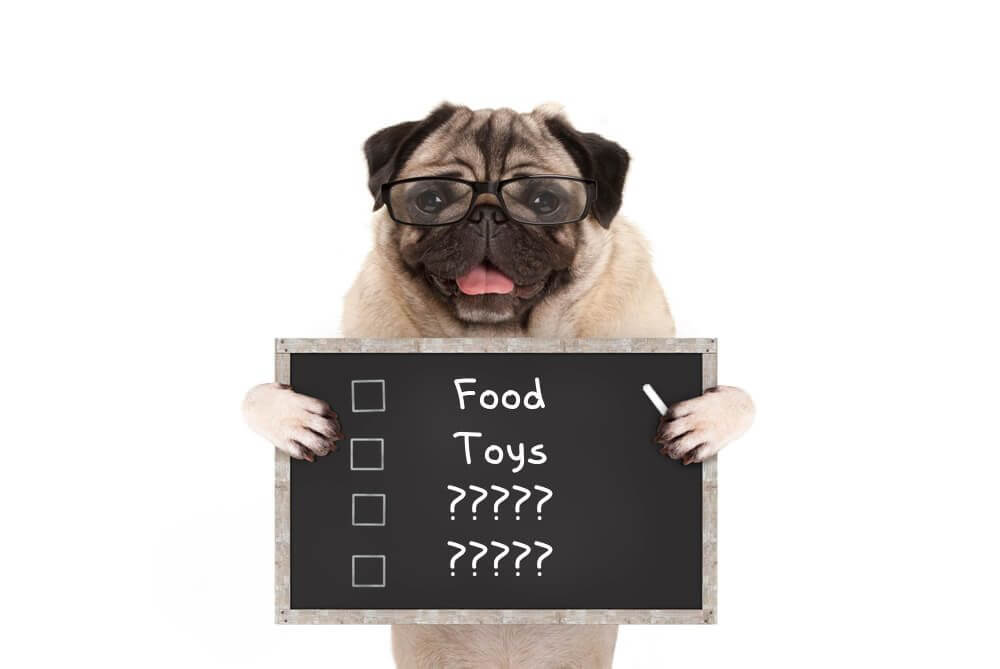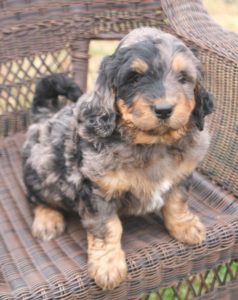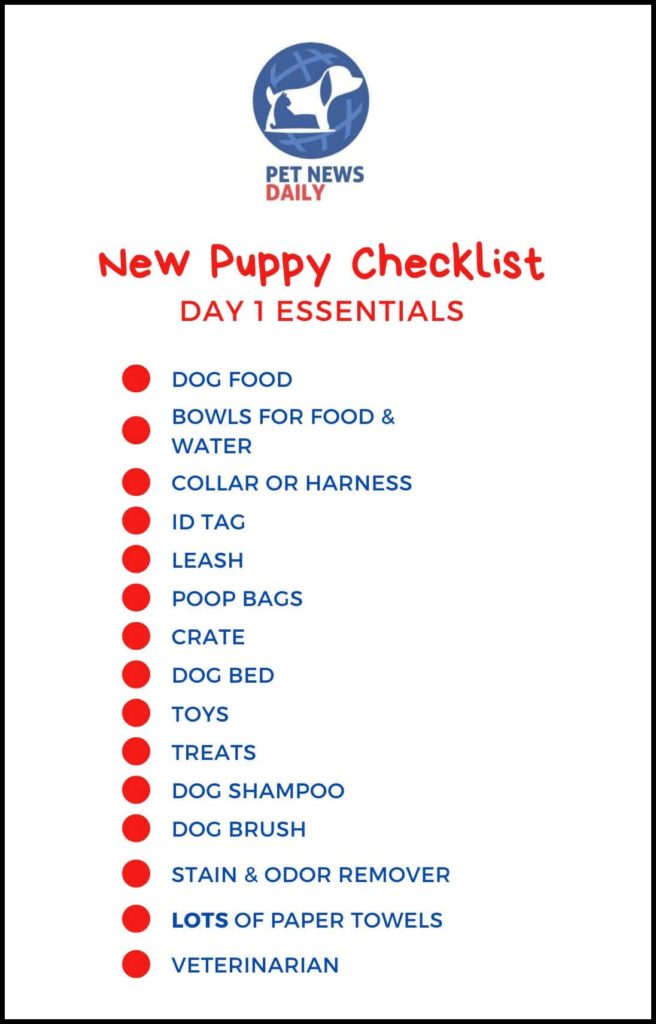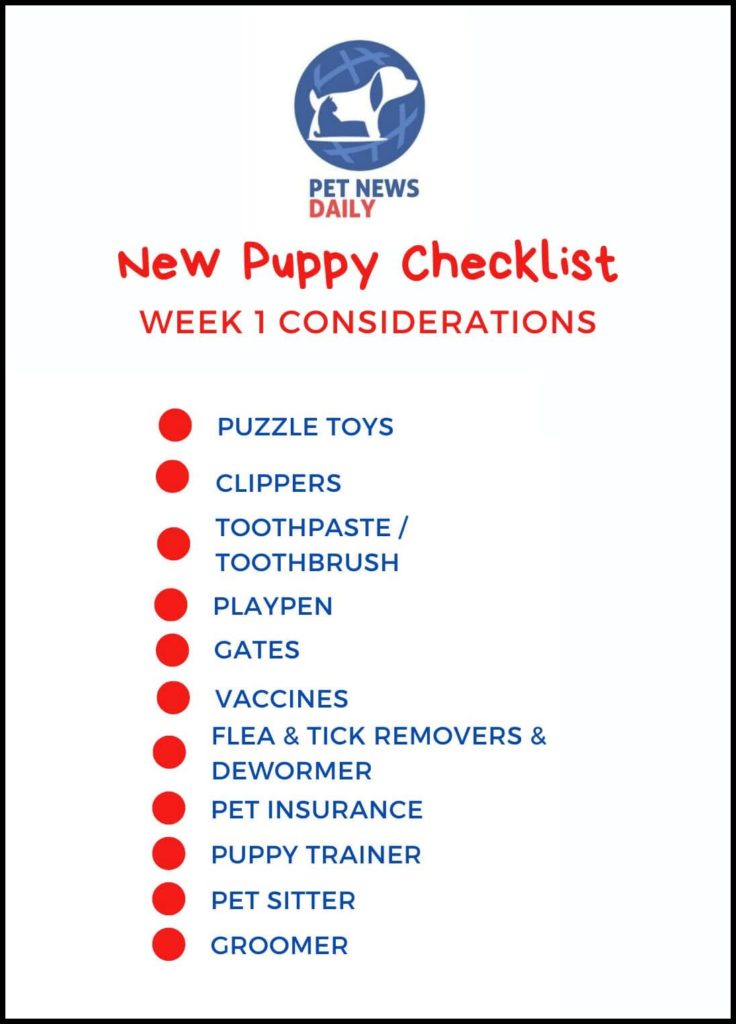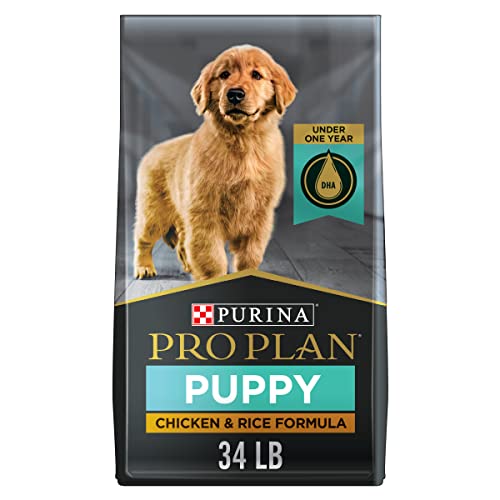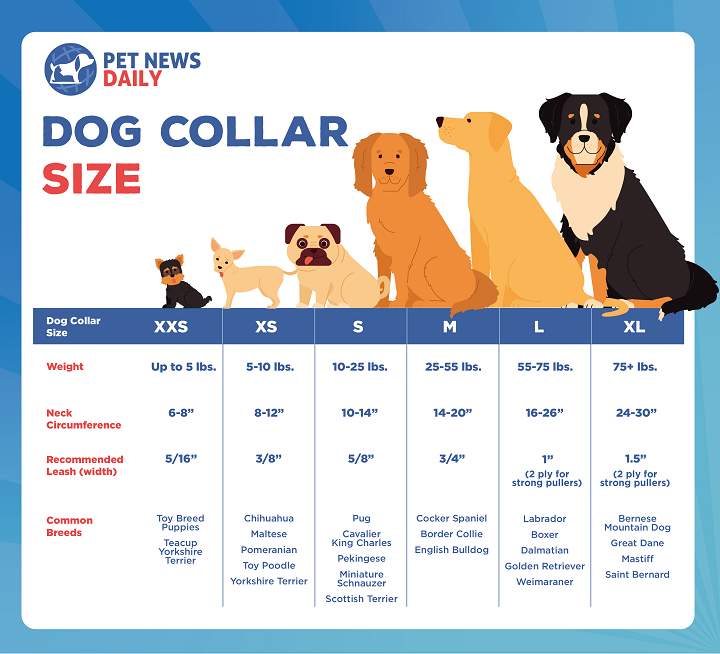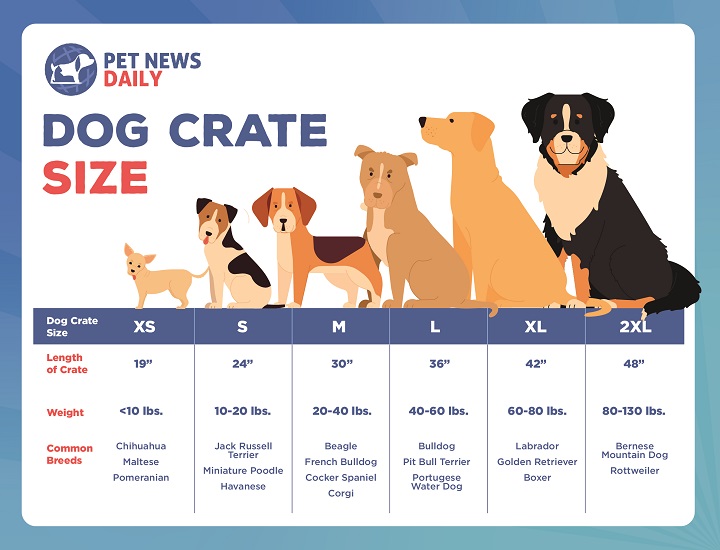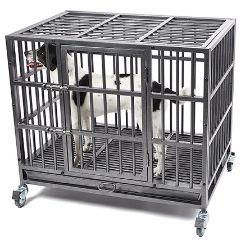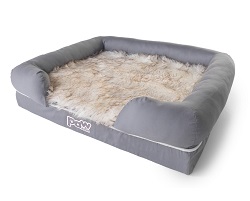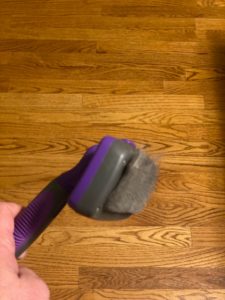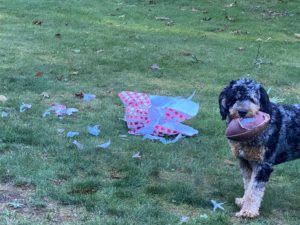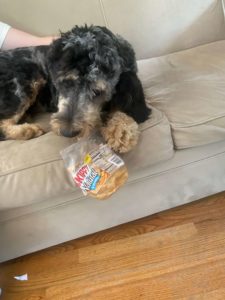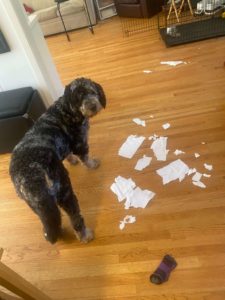Getting a new puppy is obviously exciting, but it can also be stressful.
This is a picture of Pinecone The Bernedoodle (my daughter named him – 100% approval rating for the name so far). Pinecone is now around a year old, this was him as a six week old puppy:
All the cute, right? (He’s a bit bigger now – more current pictures below, no spoilers though).
My family was very excited to get Pinecone home, but we were not fully prepared.
Lots of issues can crop up if you don’t have the right puppy supplies when you first become a puppy parent:
- Your puppy can destroy your things or make themselves sick if you don’t have the right toys (to occupy them), walking accessories (to keep them healthy and work out energy), and crates and gates (to keep them out of problem areas)
- Your dog can be malnourished if you don’t have the proper food, water, and bowls for water and food
- Your dog can be uncomfortable if you buy the wrong crate or don’t have a dog bed
- Your neighbors may be a bit upset with you if you don’t have poop bags and a pooper scooper
I’ll walk through all of that and more in this post so you can be the best pet parent possible.
I also asked our veterinary advisor Dr. Jamie Whittenburg to offer new pet owners a series of tips from a vet’s perspective about bringing home a new puppy.
You can get all of those insights in her free 5 week course, but we’ll share some of that information (particularly as it regards topics like which vaccines to give your puppy) in the post below.
Basically?
This is the checklist I wish I’d had before my best bud spent his first night in our house.
In This Article
New Puppy Checklist: EVERYTHING You Need to Know
First off, let’s get right to the checklists (lots more to follow after that).
The New Puppy Checklist is broken into two sections: Day One Essentials and Week One Considerations.
- Day One Essentials are things every new dog owner will need, and that you should have before you even get your pup home.
- Week One Considerations fall into a few buckets:
- Items or services that either some dog owners will need but not all
- Things you’ll likely need but not right away
- Things you don’t need, but should consider
We have an interactive checklist, which lets you physically check things off right here on the website, as well as a PDF which lets you print out or download the full checklist, and the images all here for you.
Interactive Checklist
Share This on Your Site (Just Copy / Paste):
If you want the checklist as a PDF to print you can either click here and get the New Puppy Checklist PDF or input your Email below and we’ll send it to you that way:
Share This (PDF) on Your Site (Just Copy / Paste)
Finally, you can grab the day 1 essentials as an image:
Or get the week 1 considerations the same way:
Day 1 Essentials Checklist: New Puppy Supplies
Now you get the general idea here in terms of what you’ll need for your dog from day one. Let’s dive into which specific products you should buy for your puppy in each category.
1. Puppy Food
The dog food you pick is obviously going to depend a ton on the breed of dog you have. Personally my vet recommended Purina Pro Plan sensitive stomach for large breeds puppy food for Pinecone (at the time he was having some digestive issues – largely because of eating his own poop but that’s neither here nor there).
Your dog may not need the sensitive stomach version, though, so you can consider the brand that’s best for your them, like the high protein variety below.
The Purina Pro Plan is a bit pricey. If you’re looking for other resources we have all kinds of vet-chosen lists of different types of dog food like the best small breed puppy foods, the best foods for dogs with allergies, and more dog food info.
2. Puppy Food & Water Bowls
I would hope any prospective puppy owners would realize they’re going to need bowls for food and water, but what kind?
My guy Pinecone is a very energetic puppy, and drinks that way. He’s been known to drink so aggressively that there’s “more water on the floor than in his belly” when he’s done. For that reason I like to have something holding his water bowls (for our smaller, older dogs we don’t find this necessary).
We tried a “no spill / no slip” brand – that may be a fit for some but Pinecone would actually flip over both bowls knocking them out of the container, then chew on the rubber no spill / stain mat (true story – he’s a bit of a handful).
What worked much better for us was a tray that held the bowls (for the bowls themselves I’d recommend stainless steel bowls over plastic bowls) – this is a great one:
The neat thing about this set is its adjustable so you can ratchet it up or down depending on the size of your dog as your puppy grows.
3. Puppy Collar or Harness
Picking the right collar for your dog can be tricky. We actually created a great dog collar size chart (if I do say so myself, which I do) and a companion article about how tight your dog’s adjustable collar should be (written by our veterinary advisor Dr. Jennifer Masucci).
Share This Dog Collar Size Chart on Your Site
You may not even want to go with a collar – for Pinecone we have both a few collars and a few harnesses. It seems like there’s some difference of opinion among experts on which is the best approach. Some trainers say a collar is important as a training tool, and some say the pull on the dog’s neck is unhealthy and a harness is better for them.
Our vets have reviewed a variety of harnesses (including no pull, the best dog lift harnesses, and the best escape proof dog harnesses). The escape proof dog harness article is one of our most popular, and our vet advisor Dr. Addie Reinhard chose the Ruffwear Webmaster Harness (click that link for an in-depth review of that harness, as well).
4. Puppy ID Tags
Getting your puppy an ID tag with your information on it is always a good idea. There are lots of good options, my personal preference is a stainless steel engraved one like this one:
But many of them are pretty similar in terms of function.
5. Puppy Leashes
To walk your new puppy you’ll obviously need a leash. In general leashes don’t leave you with the moral quandaries of collars vs harnesses, and it’s easier to figure out the size. If you have a large breed puppy you’ll need something more durable, of course. A lot of harnesses will come with a leash, as well.
For smaller dogs I like the retractable leashes so that you don’t run into tangles. Pinecone – as you maybe figured out by this point in the article – can not be contained by such leashes. We use a leather leash for him, here is a great model:
6. Puppy Poop Bags
There is no worse feeling in the world than being on a walk with your dog, them starting to squat, and you realizing you forgot your dog poop bags. You can get into fights, even lawsuits with neighbors over not cleaning up after your dog.
Poop bags are critical. If you’re lucky, you will have a well behaved dog that doesn’t try to eat the dog poop bags every time he sees them (including when they have actual poop in them – wait until you see these pictures of Pinecone the Destroyer at the end of the post).
For that reason, I typically buy these in bulk. Amazon basics has a very cheap line of poop bags (the lavendar scented ones actually do smell pretty good – until they serve their purpose, anyway) and this biodegradable line is actually a bit cheaper per bag.
7. Puppy Crates
As with collars, picking the right sized crate for your dog is key. We have a helpful dog crate size chart to help with this as well (with help from our veterinary consultant Dr. Jennifer Coates):
Share This Dog Crate Size Chart on Your Site
Dr. Addie Reinhard reviewed the top heavy duty dog crates (Pinecone is now pushing 90 lbs at under a year old, so we definitely need a large dog crate) here was her pick:
Half-inch, 22-gauge steel with welded stress points keeps dogs safe and secure.
Pay attention to the dog crate size chart: you don’t want to get something too big, but we had two crates that Pinecone outgrew which can be a major hassle (and cost) if you’re not smart about crate sizing from the jump.
If you have a smaller dog, getting a crate can be a little more straightforward. We’ve bought this crate twice for our two smaller, older dogs and its been great (and only around $25).
8. Puppy Beds
For his part, Pinecone is a sprawl out on the floor kind of a guy, but our smaller dogs do like to snuggle in a bed on occasion. It’s a good idea to have some dog bedding options (and potentially some blankets) set up for your pup when you bring them home.
There are lots of different options when it comes to dog bedding. We’ve written extensively on this topic, with guides to outdoor beds, sofa beds, elevated dog beds, and more.
Even though potty training Pinecone has gone better than *ahem* some other aspects of his training, I’m a big fan of waterproof dog beds just in case the process doesn’t go as smoothly for your dog.
Here is vet advisor Dr. Amanda Jondle’s top pick:
An extremely comfortable bed with a supportive bolster and a faux fur topper.
Don’t forget to check out our tips for getting a puppy to sleep through the night, as well.
9. Puppy Toys
Having lots of options for dog toys available when your dog gets home is key. You can’t really tell what toys a dog will take to, so I’d recommend getting a bit of a mix of different types of toys to see what your dog likes.
It’s not a “toy” strictly speaking, but Pinecone is a very “food motivated” dog who doesn’t like to sit still when being brushed or groomed, so our vet recommended a lick mat. I like the thinner lick mats like this one as the thick ones (like this) require a lot of peanut butter (what we use for this purpose) which is very calorie dense.
Again for toys it’ll likely be a personal preference for your dog – I’d try some different categories of toys, such as:
- Toys that squeak
- Dog bones
- Dog toys with treats embedded in them (basically small puzzle toys)
- Puzzle toys for dogs (which can be great for slow feeding and mental stimulation)
Be mindful of the size and aggression of your dog when it comes to toys – Pinecone will destroy pretty much anything he comes in contact with and small toys can be a choking hazard for him. Multiple dogs can also be aggressive when it comes to toys, particularly those with treats embedded in them or with dog bones.
10. Puppy Treats
Treats are an important part of leveraging positive reinforcement while training your puppy. Pinecone is a bacon flavor kind of a guy, but he’s not picky at all when it comes to training treats. Again here I’d recommend trying a few different types of treats and seeing what your puppy likes best.
11. Puppy Shampoo
If potty and crate training don’t go as planned early on, you’ll want to have some shampoo handy. You can actually use baby shampoo to bath your dog, but finding a sweet smelling shampoo you like that’s made for dogs is a good idea.
We’re a Nature’s Miracle family (more on that below) so here’s my personal top pick:
12. Puppy Brush
Having a brush ready to avoid any mats in your puppy is key, especially if you have a breed that needs to be brushed frequently (like Bernedoodles).
Our vet advisor Dr. Chyrle Bonk recommended the GM pets self cleaning slicker in her review of the best dog brushes for Australian Shepherds.
I bought it based on her recommendation, and I have to say I do really love it. Pinecone is not currently a fan of being brushed in general:
But it does a great job of catching hair and brushing out mats without being overly uncomfortable for your puppy:
So that’s our top pick:
13. Stain & Odor Remover
Your puppy may have a way to go with potty training, and may get into something they shouldn’t leading them to throw up some. If either or both of these are the case, you want to have a good stain and odor remover on hand.
Personally I find all of the Nature’s Miracle products really are a bit of a miracle at getting out smells and stains.
I’d recommend having the Urine Destroyer, a fabric cleaner, and potentially a larger order of pet cleanup solvent on hand, depending on what you’re dealing with. If you go with another brand just make sure you have an enzyme spray to help break down urine stains.
And a bonus tip: Windex. It doesn’t do much for the smell, but it’s very versatile in terms of being able to go on all kinds of surfaces for clean up, so stock up.
14. LOTS of Paper Towels
This one is preventative in case the crate and potty training don’t go well – enough said, I’m sure you can find these on your own.
15. Find a Veterinarian
It’s critical to have a vet lined up before you bring your dog home. If you can get a referral from a family member or friend that’s a great way to go.
Week 1 Considerations: More Puppy Equipment, Vet & Training Checklist Items
You can’t necessarily get everything ready at once when you’re bringing home your puppy. If you need to work in phases, the items above are absolutely essential. These next items will be important for some breeds, may be essential but may not be something you need to deal with right away, or might be more of something to consider (and not a necessity).
1. Puzzle Toys
When Pinecone first got into puzzle toys, I thought he was some sort of savant. He absolutely loved them, and seemed to “solve” them pretty quickly.
I learned that he was basically just flipping them over and ripping the pieces out of them. Regardless, though, they can be a great way to slow feed your dog and keep their minds busy.
I have tried probably pretty much every puzzle toy on the market. I don’t like to have the puzzle toy be overly simple, and I don’t want them to have pouches that are too big so I’m not over-feeding while I’m slow feeding. This is one of my favorites for those reasons, and because of the interactivity of the puzzle here’s my top pick:
Clippers
If your dog requires a lot of grooming you may want to get clippers and other grooming tools sooner rather than later. Vet advisor Dr. Bonk reviewed the top grooming clippers and this was her number one pick:
Dental
You may also consider picking up some toothpaste and / or a toothbrush for your dog.
Playpen
Depending on your yard and your home, you may want to consider a dog playpen, an outdoor kennel, or even some sort of dog fencing to keep your dog contained.
Our vet advisor, Dr. Jamie Whittenburg, selected this as the top playpen:
Gates
Gates are key – we have gates at the top and bottom of a variety of stair cases, and need to gate of the kitchen in our house to keep Pinecone from counter surfing and getting into areas he shouldn’t.
There are lots of attractive gate options for around $80-100. We have the gate below and have been happy with it (it was easy to install and doesn’t come down easily):
Vaccines
This is obviously something you’ll want to work out with your vet. In her free course Dr. Jamie Whittenburg DVM outlined the following regarding vaccines for your puppy:
How do puppy vaccines work?
Puppy vaccines will typically begin between six and eight weeks of age. Additional doses will be given every 2-4 weeks, depending on the veterinarian’s preference and the puppy’s lifestyle. In total, each pup should receive four to five sets of puppy vaccines.
When your veterinarian gives your puppy a vaccine, the immune system will be activated. The protection from the vaccine will lag behind the actual vaccine administration by approximately two weeks. This lag should be kept in mind following the final set, before the puppy is taken to areas that may expose them to infectious diseases.
Multiple doses of the vaccines are given to puppies because they may still have antibodies circulating in their systems that they received from their mothers. These maternal antibodies protect the very young puppy in their first few weeks of life but will interfere with the vaccine-induced antibody production. It is impossible to know when your puppy’s maternal antibodies have disappeared, so vaccines will be given regularly until four to five months of age to ensure they are effective.
Typical Puppy Vaccine Schedule:
Age Core Vaccines
6 to 8 weeks Distemper, Parvovirus, Adenovirus, Parainfluenza
9 to 11 weeks Distemper, Parvovirus, Adenovirus, Parainfluenza
12 to 14 weeks Rabies, Distemper, Parvovirus, Adenovirus, Parainfluenza
16+ weeks Distemper, Parvovirus, Adenovirus, Parainfluenza
Non-Core Vaccines
Bordetella, Influenza, Leptospirosis, Rattlesnake, Lyme
These non-core vaccines may be recommended for your puppy based on their geographical area, breed, and anticipated lifestyle. For example, dogs that are going to be groomed or boarded at a kennel will likely require the Bordetella vaccine. Dogs that are used for hunting or that spend time on ranches in certain areas may benefit from the rattlesnake vaccine. Talk to your puppy’s veterinarian about which non-core vaccines may be right for them.
Side Effects of Vaccines
Side effects due to puppy vaccines are relatively rare. Mild soreness, local inflammatory reactions (bumps), tiredness, and low-grade fever are possible. These side effects are typically mild and self-limiting. They are also a signal that the puppy’s immune system is responding appropriately.
There is always a small risk of a severe allergic reaction, or anaphylaxis, any time a vaccine or medication is administered to a human or animal. Following the administration of a vaccine, if you observe hives, swelling of the face or ears, difficulty breathing, vomiting, or loss of control of the bowel and bladder, you should take your puppy back to their veterinarian or an emergency clinic immediately.
Final Thoughts
Vaccines are one of the best and easiest ways to protect your puppy and keep them healthy. Vaccine preventable diseases such as distemper and parvovirus are very common in unvaccinated puppies. These diseases are often fatal, even with veterinary treatment. Puppy vaccine visits will start a relationship with your veterinarian and enable them to keep your new puppy healthy and happy! Each vaccine visit will also allow a veterinarian to examine your puppy, enabling them to catch any health issues early
If you want to track the vaccine schedule for your puppy against Drk. Whittenburg’s recommendations, here is the puppy vaccine schedule she laid out above (you can have it sent to you via Email if that’s helpful as well):
Share this Puppy Vaccine Schedule On Your Site
Flea, Tick & Dewormer
Similarly, this is something you’ll want to get squared away with your vet, ideally at the first visit.
Pet Insurance
In that same free course Dr. Whittenburg has the following to say about weighing whether you need pet insurance for your dog:
What is Pet Health Insurance?
Pet health insurance helps owners cover the cost of necessary medical care for their pets. Insurance often covers routine preventative care, accidents and illnesses, cancer treatment, emergency care, and even prescription medications. Most pet health insurance companies work from a reimbursement model where the owner pays the veterinarian up front and then applies for reimbursement from the insurance company.
It is important to note that for pet health insurance to be effective, owners must have the ability to pay the veterinarian when services are rendered and then apply for reimbursement. This may be a credit card or savings account, but all pet owners must be prepared for this. A few pet health insurance companies will pay the veterinarian directly, but the veterinarian used must be in their network.
When Should I Purchase Pet Health Insurance?
The best time to purchase pet health insurance for your dog is when they are young and healthy. Pet health insurance rarely covers pre-existing conditions, so it is vital to have coverage in place before your puppy has any health issues.
How Much Does Pet Halth Insurance Cost?
Pet health insurance plans vary based on things such as breed, age, pre-existing conditions, and geographical location. On average, you should expect to pay around $600 a year for a dog’s accident and illness plan.
There are other options, including accident only and even preventive care only plans that may be more affordable but still help ease the burden of paying for veterinary care. It is also important to note that the premium you pay when you purchase pet health insurance for your puppy will not be locked in. Rates for pet health insurance raise as the dog ages, so be sure to ask about the company’s policies. Often pet owners find themselves unable to afford rising premiums at the exact age that their pet needs pet health insurance the most.
Are there Good Alternatives to Pet Health Insurance?
As a practicing veterinarian, I have seen firsthand how difficult it can be for owners to pay for their pet’s healthcare. It is heart-wrenching to have to make medical care decisions for your beloved pet based on limited finances. Pet health insurance can be a great option for many owners, enabling them to provide the necessary care for their pet needs. However, because of the need to be able to pay upfront, rising premiums, and exclusions of coverage, there may be better ways to plan.
Savings Accounts
Starting a savings account for your new puppy may be the best way to ensure that you can pay for their necessary health care. Funds deposited into a savings account will be available 100% for use for your pet as opposed to paying a monthly premium to a pet insurance company.
Though this approach requires some discipline on the part of the owner, it has several distinct advantages over pet health insurance. For one, there is no money lost to premiums. If your puppy stays healthy, the money will accumulate and can either be spent on routine and preventative care or allowed to grow until it is needed. Additionally, a savings account will always be available to be spent. There is no need to worry about being able to pay upfront or waiting for reimbursement. Lastly, a savings account eliminates the circumstance of an aging pet losing its coverage due to unaffordable premium increases.
The downsides to using a savings account are that you might not have enough saved up in the event that your puppy requires expensive care when young and you haven’t had a chance to save very much. Also, the pet owner must be disciplined to make regular contributions to the account and not use the money for anything other than health care for the pet.
Final Thoughts
With major technological advances in veterinary medicine, we can provide state-of-the-art care to pets and help them live longer and healthier lives. Unfortunately, these advances come with higher price tags, and it is imperative that new puppy owners are prepared. All owners should evaluate their financial situation and, if needed, purchase pet health insurance to start a savings account for their pet.
Puppy Trainer
You want to consider a puppy trainer, or potentially an online training course.
Pet Sitter
Similarly getting a pet sitter lined up is another key for early in your puppy’s life.
Groomer
Similarly even if you have a great brush, comb, and clippers you still want to find a good groomer near you.
Puppy Gift Boxes
If you’re welcoming someone else’s puppy home, there are a few places to get puppy gift boxes or welcome home boxes. These won’t be as comprehensive as running through the checklists here and getting everything you need, but they can be a nice start or a great gift:
What You Need By Breed
While most of the items in a new puppy checklist will be universal (with some adjustments to things like the size of a crate, the type of dog bed, the types of toys or food, etc.) some breeds will have specific needs.
Here are a few breeds and how you might modify a checklist for each:
- Golden Retriever – I had a Golden named Flash growing up. You’ll want a great brush for your Golden Retriever because while they have beautiful hair, they shed a lot and need to be brushed consistently. You’ll also want to get a larger crate, and large breed puppy food. If you’re not sure about crate size, you can get a sense of how big your Golden will be with our Golden Retriever growth chart.
- Labrador – A Labrador is another breed where you’ll need good grooming materials. Here again we have a great growth chart to help you with crate sizing.
- French Bulldog – French bulldogs won’t have the same grooming requirements as labs, goldens and doodles, but will require things like puzzle toys to keep them occupied and a specific food type, as well as a number of the other standard checklist items.
- Goldendoodle – Goldendoodles are an incredibly popular breed these days. As someone who grew up with a Golden and currently has a doodle, I do love this breed. Similar to some of the breeds above: have a great grooming kit, and check out our Goldendoodle growth chart to help with crate sizing (Know more about Goldendoodle growth chart in our weigh calculator).
- Dauschaund – My family actually has a Dauschaund too! These little guys are much different than some of the bigger breeds above. They need less grooming, smaller crates, and very different food. You may also be able to worry less about things like gates in certain areas of your home as there’s a lot less concern about counter surfing (unless you have teeny, tiny counters).
Frequently Asked Questions
Generally it’s a good idea to have your puppy sleep in a crate near your bed.
Make sure you have all of the essential puppy items outlined in our checklist and have a veterinarian appointment booked for your new puppy.
The main things you need for a new puppy are: food, bowls, fresh water, collar or harness, leash, ID tag, poop bags, crate, dog bed, toys, treats, dog shampoo, dog brush, stain & odor remover, and an appointment with a veterinarian.
To help settle your puppy at night you can follow a few steps: make sure they get enough exercise, develop a routine, give them a bathroom break before bed, crate train, stimulate them mentally, give them something to chew on, and consult with a vet or trainer if you’re still having issues.
The checklist of things you need for a new puppy should include:
- Food
- Bowls
- Collar or harness
- Leash
- ID tag
- Poop bags
- Crate
Dog bed - Toys
- Treats
- Dog shampoo
- Dog brush
- Stain & odor remover
- An appointment with a veterinarian
Additional Resources
If you’re more of a visual learner, there are a lot of great videos about what to have ready for your new puppy as well.
First, here’s one from dog trainer Zak George:
And another from McCann Dog Training:
And finally another from prolific dog rescuer Rachel Fusaro:
BONUS: Pinecone The Destroyer Pictures
I teased it in the intro so I’ll close with some pictures of the world’s sweetest, but worst-behaved Bernadoodle in action.
Here is Pinecone, now close to 90 pounds, with “his” football standing next to what had been a tablecloth before it met it’s match in the Pinester:
He likes peanut butter:
And melatonin? (I did not let him get the actual melatonin, if you’re scoring at home).
And finally a perfect visual as to why you want to have lots of paper towels stocked before you bring home your puppy:
It’s cliche to say but as you can see from the pictures: puppies are often both very cute, and very much a full time job. Good luck!
